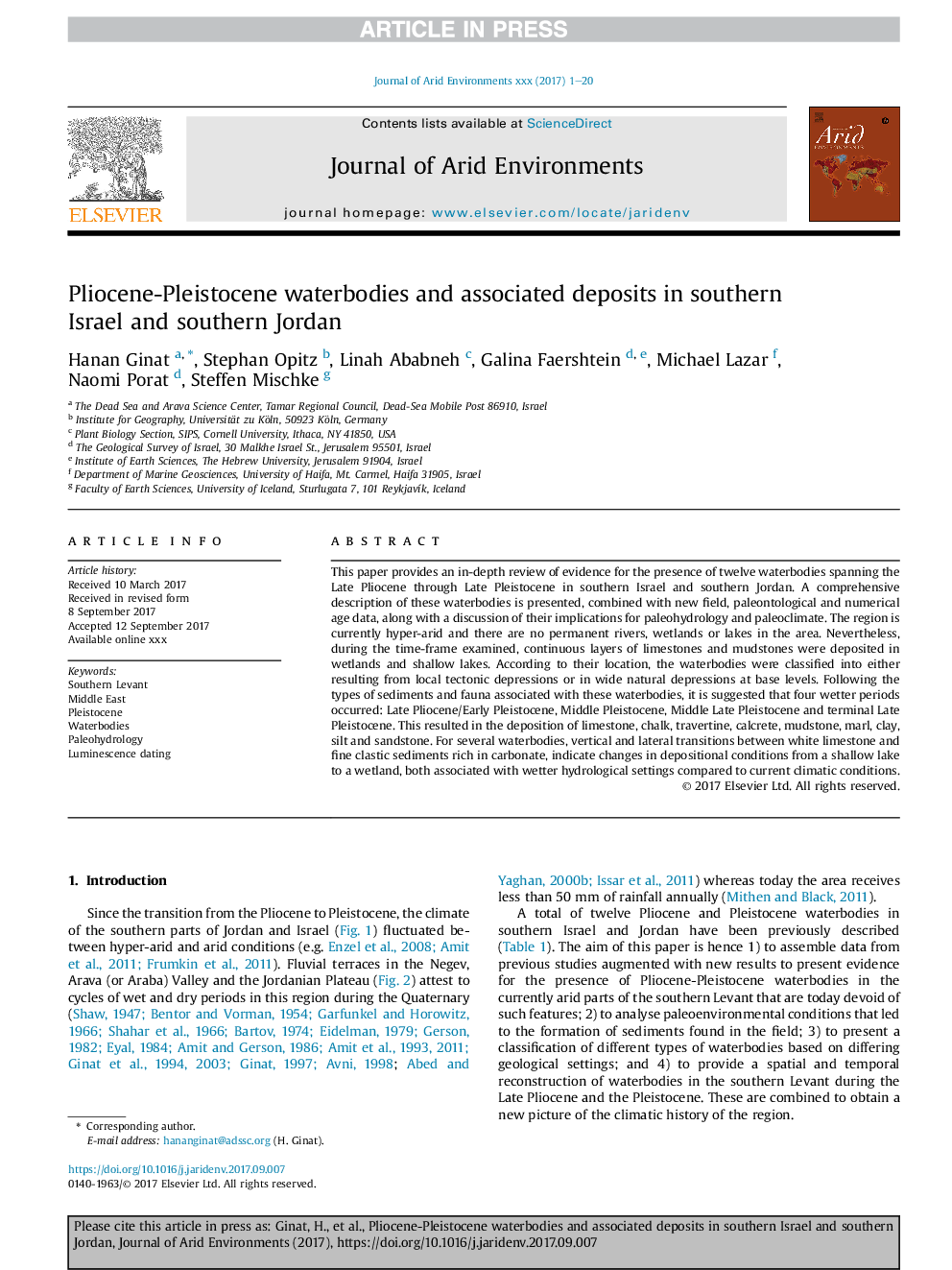| کد مقاله | کد نشریه | سال انتشار | مقاله انگلیسی | نسخه تمام متن |
|---|---|---|---|---|
| 8848610 | 1618211 | 2018 | 20 صفحه PDF | دانلود رایگان |
عنوان انگلیسی مقاله ISI
Pliocene-Pleistocene waterbodies and associated deposits in southern Israel and southern Jordan
ترجمه فارسی عنوان
آبزیان پلیوسن-پلیستوسن و ذخایر مربوطه در جنوب اسرائیل و جنوب اردن
دانلود مقاله + سفارش ترجمه
دانلود مقاله ISI انگلیسی
رایگان برای ایرانیان
کلمات کلیدی
ترجمه چکیده
این مقاله بررسی جامعی از شواهد موجود برای حضور دوازده آبراهه ای را که پیلوزن اوایل پس از پیدایش پریستوکن در جنوب اسرائیل و جنوب اردن است، ارائه می دهد. توصیف جامع این آبراهه ها همراه با داده های جدید زمینه ای، دیرینه شناسانه و عددی ارائه شده است، همراه با بحث در مورد پیامدهای آنها برای پائول هیدرولوژی و پائول کلمیت. این منطقه در حال حاضر بیش از حد خشک است و در این منطقه هیچ رودخانه، تالاب یا دریاچه دائمی وجود ندارد. با این وجود، در طول زمان بررسی شده، لایه های پیوندی از سنگ آهک ها و سنگ های معدنی در تالاب ها و دریاچه های کم عمق ذخیره می شوند. با توجه به موقعیت آنها، آبراه ها به عنوان یا ناشی از افسردگی های زمین شناسی محلی یا در رگرسیون های طبیعی طبیعی در سطوح پایه طبقه بندی شدند. با توجه به انواع رسوبات و جانوران مرتبط با این آبراهه ها، پیشنهاد می شود که چهار دوره مرطوب وجود داشته باشد: پیلوئوس پسین / اوایل پیلستوکن، پیلوستوکن میانی، پیلوستیکن بعد از اواسط و انتهای پیلیست اتن بعد. این منجر به رسوب آهک، گچ، تراورتن، کلرکت، گرانول، مارن، خاک رس، نمک و ماسه سنگ می شود. برای چندین آبرودار، انتقال عمودی و جانبی بین سنگ آهک سفید و رسوبات کلاسیک خوب حاوی کربنات، تغییرات در شرایط رسوب را از یک دریاچه کم عمق به یک تالاب نشان می دهد، که هر دو در تنظیمات هیدرولوژیکی مرطوب نسبت به شرایط آب و هوایی فعلی مرتبط است.
موضوعات مرتبط
مهندسی و علوم پایه
علوم زمین و سیارات
فرآیندهای سطح زمین
چکیده انگلیسی
This paper provides an in-depth review of evidence for the presence of twelve waterbodies spanning the Late Pliocene through Late Pleistocene in southern Israel and southern Jordan. A comprehensive description of these waterbodies is presented, combined with new field, paleontological and numerical age data, along with a discussion of their implications for paleohydrology and paleoclimate. The region is currently hyper-arid and there are no permanent rivers, wetlands or lakes in the area. Nevertheless, during the time-frame examined, continuous layers of limestones and mudstones were deposited in wetlands and shallow lakes. According to their location, the waterbodies were classified into either resulting from local tectonic depressions or in wide natural depressions at base levels. Following the types of sediments and fauna associated with these waterbodies, it is suggested that four wetter periods occurred: Late Pliocene/Early Pleistocene, Middle Pleistocene, Middle Late Pleistocene and terminal Late Pleistocene. This resulted in the deposition of limestone, chalk, travertine, calcrete, mudstone, marl, clay, silt and sandstone. For several waterbodies, vertical and lateral transitions between white limestone and fine clastic sediments rich in carbonate, indicate changes in depositional conditions from a shallow lake to a wetland, both associated with wetter hydrological settings compared to current climatic conditions.
ناشر
Database: Elsevier - ScienceDirect (ساینس دایرکت)
Journal: Journal of Arid Environments - Volume 148, January 2018, Pages 14-33
Journal: Journal of Arid Environments - Volume 148, January 2018, Pages 14-33
نویسندگان
Hanan Ginat, Stephan Opitz, Linah Ababneh, Galina Faershtein, Michael Lazar, Naomi Porat, Steffen Mischke,
